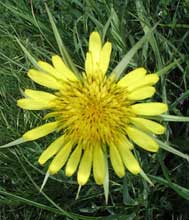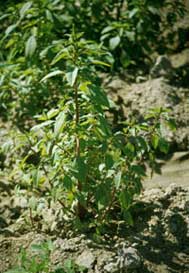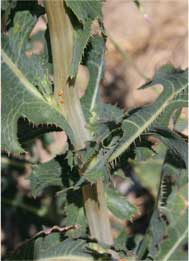Weed Seed Longevity/Viability
Nylon mesh packets of various weed seeds were buried on December 15, 2008 in peppermint, on February 17, 2009 in native spearmint, and again on November 3, 2009 in peppermint. Experimental design is described on the Weed Science page of this website. Below are the results of unearthing the seed packets, counting the intact seeds, and subsequently attempting to germinate those seeds.
Western Salsify Seed
Only one seed packet contained two intact Western salsify seed, whereas the remaining seed packets had no intact salsify seed. The two seeds recovered were viable and germinated. Most salsify seeds appeared to have germinated within the nylon mesh packets during the 9 to 12 month course of each study. Salsify seed has a low level of dormancy and readily germinates when conditions are favorable, thus it tends to be a short-lived seed in the soil.
Redroot Pigweed Seed
Irrigation level did not significantly impact the number of intact redroot pigweed seed recovered from seed packets which averaged 95 and 97% recovery for 9 and 12 months of burial, respectively. The number of intact seed recovered tended to be above 90%, indicating that most redroot pigweed seed did not germinate within the seed packets or degrade over the 9 to 12 month burial period. The number of seed recovered was slightly greater at 12 month compared to 9 month burial in the two years of peppermint studies. We cannot explain this slight increase in seed recovery with the longer time of burial and although statistically significant, it is unlikely a real difference.
The percent germination of the recovered redroot pigweed seed was not significantly affected by length of burial from 9 to 12 months but was significantly affected by irrigation level (P=0.0214) and mint type (P<0.0001). Percent germination of recovered redroot pigweed seed was much greater (51 to 57%) in native spearmint and in year 2 peppermint than in year 1 peppermint (7%) averaged over all irrigation treatments and time of burial. The low germination of seed recovered from the Year 1 peppermint study could be due to an induced dormancy of the pigweed seed or a reduction in seed viability in the peppermint study by some unknown environmental factor. The peppermint study was irrigated to field capacity after the first harvest of mint in both years, whereas irrigation treatments in the native spearmint trial were constant the entire irrigation season, and this may have impacted pigweed seed dormancy in Year 1.
| Crop | Irrigation Regime | Months Buried | No. Seed Recovered (out of 100) | % Germination of Recovered Seed |
|---|---|---|---|---|
| Native Spearmint | 100% (wet) | 9 | 94 | 59 |
| 12 | 98 | 68 | ||
| Medium | 9 | 100 | 69 | |
| 12 | 98 | 58 | ||
| Dry | 9 | 99 | 61 | |
| 12 | 98 | 31 | ||
| Peppermint (Year 1) | 100% (wet) | 9 | 89 | 5 |
| 12 | 97 | 11 | ||
| Medium | 9 | 90 | 10 | |
| 12 | 97 | 12 | ||
| Dry | 9 | 94 | 2 | |
| 12 | 98 | 4 | ||
| Peppermint (Year 2) | 100% (wet) | 9 | 95 | 66 |
| 12 | 99 | 46 | ||
| Medium | 9 | 97 | 68 | |
| 12 | 97 | 43 | ||
| Dry | 9 | 96 | 41 | |
| 12 | 95 | 39 |
Prickly Lettuce Seed
Irrigation treatment did not significantly impact the number of intact prickly lettuce seed recovered from seed packets.The number of prickly lettuce seed recovered was significantly affected by the number of months buried and the mint type. There was also a significant interaction between the mint type and number of months buried on total prickly lettuce seed recovered. The number of intact prickly lettuce seed recovered tended to be slightly greater from the native spearmint (75/100 seed) compared to the peppermint (67 and 55/100 seed for Years 1 and 2, respectively), indicating that more seed had either germinated or rotted in the two peppermint studies. The number of intact seed recovered was greater at 9 months than at 12 months of burial in native spearmint and Year 2 peppermint. However, the number of prickly lettuce seed recovered from peppermint in Year 1 was similar after 9 and 12 months of burial.
Time of burial did not significantly impact the percent germination of recovered prickly lettuce seed. Germination of the recovered prickly lettuce seed was significantly affected by irrigation treatment and mint type, but there was no significant interaction. Percent germination of recovered prickly lettuce seed increased as irrigation level increased over all three studies. Perhaps the drier conditions in the deficit irrigated plots induced dormancy in prickly lettuce seed or reduced viability of the seed. Percent germination of recovered seed also was greater from the seed packets collected from the native spearmint and Year 2 peppermint (75%) trials compared to those from the Year 1 peppermint (50%) trial over all irrigation treatments.
| Crop | Irrigation Regime | Months Buried | No. Seed Recovered (out of 100) | % Germination of Recovered Seed |
|---|---|---|---|---|
| Native Spearmint | 100% (wet) | 9 | 88 | 89 |
| 12 | 61 | 81 | ||
| Medium | 9 | 83 | 84 | |
| 12 | 74 | 71 | ||
| Dry | 9 | 80 | 80 | |
| 12 | 67 | 43 | ||
| Peppermint (Year 1) | 100% (wet) | 9 | 67 | 73 |
| 12 | 72 | 72 | ||
| Medium | 9 | 58 | 42 | |
| 12 | 66 | 48 | ||
| Dry | 9 | 73 | 37 | |
| 12 | 65 | 27 | ||
| Peppermint (Year 2) | 100% (wet) | 9 | 65 | 97 |
| 12 | 51 | 86 | ||
| Medium | 9 | 57 | 81 | |
| 12 | 51 | 75 | ||
| Dry | 9 | 66 | 53 | |
| 12 | 40 | 58 |
Weed Science subpage
This page is designed to provide additional information pursuant to the Food Science component of the overall project discussed on the Washington State University website http://hopmintstress.wsu.edu .
It is not designed to be viewed or utilized independently of that website.

Western salsify

Redroot pigweed

Prickly lettuce